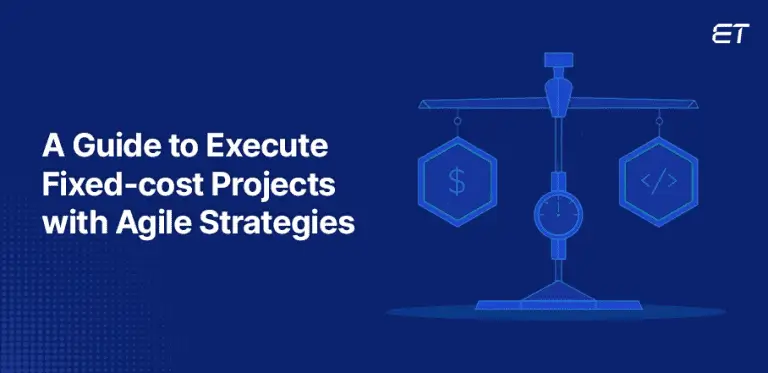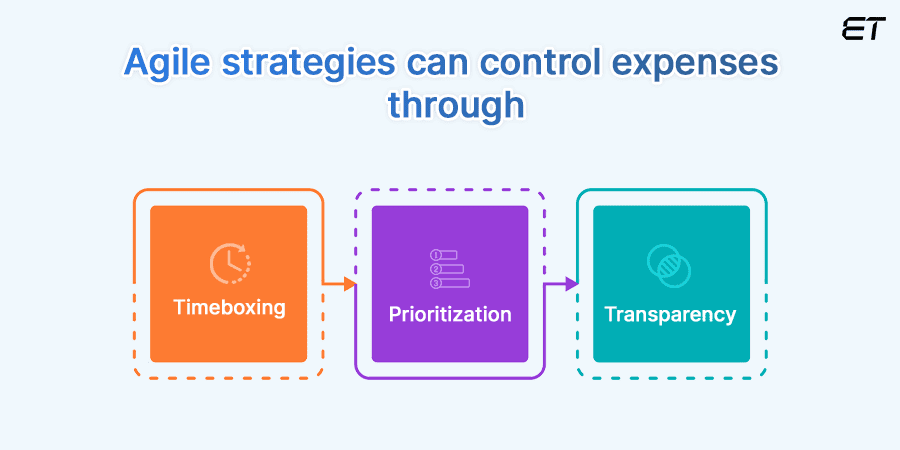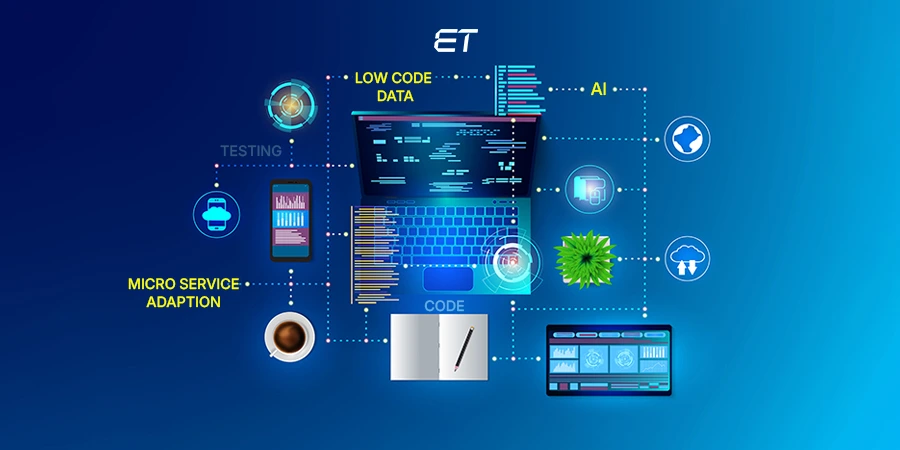
Agile Strategies for Fixed-Cost Web Development Projects
Here’s a favorable scenario – you receive a high-quality web development project on time and within budget. So, what’s one of the secrets behind this outcome? Its agile strategies.
Agile can be a great methodology for delivering the desired results in any web development project. Yes, agile strategies can prove extremely effective even if you choose the fixed-cost model.
In this blog, we’ll explain how agile principles can lay a strong foundation for success. As a business, you can understand how agile can combine with fixed-cost models to keep your project on track. So, read ahead to learn more about agile business strategies and some vital pointers.
Agile Strategy: Understanding Client Requirements

The best software development companies adopting agile software methodologies are well aware of your needs. Here’s a quick explanation:
- Preference for fixed-cost model: Let’s face it. You might admire the security and clarity of fixed costs. This collaboration model reduces risk of information shortage
- The drawback: A rigid fixed-cost model can cause missed opportunities and develop an off-target product
Agile strategies in a fixed-cost model can prove to be the perfect solution. These tactics lead to continuous discovery. How?
Well, here are some techniques that best companies use to implement agile strategies:
- User Interviews & Workshops: The best IT firms delve deep to understand the client’s target audience, their pain points, and desired user experience.
- Story Mapping: They build a visual representation of the core functionalities, prioritizing them based on value and user needs.
- Acceptance Criteria: Along with your team, the best firms define clear and measurable criteria for each user story.
Agile development strategies don’t eliminate upfront planning. However, they help introduce a fixed-scope discovery phase.
In this phase, dedicated developers focus on core functionalities, user stories, and acceptance criteria. These factors lay a strong foundation for accurate estimations and prevent scope creep in your project.
Overall, by implementing these agile techniques, professionals can foster collaboration and build a shared understanding with the client. This transparency sets the stage for a successful fixed-cost project that delivers true value.

How to Build a Solid Foundation Using Agile Strategies?

Agile strategies can help build a solid foundation in fixed-cost web development projects. To bring this statement into reality, reputed development companies focus on the following aspects.
Focus on Core Agile Values
Transparency, collaboration, and continuous improvement are the pillars of agile business strategies.
These values become even more critical in a fixed-cost project. The best companies share information transparently, work hand-in-hand with the client and constantly refine the project based on feedback.
Establish the Discovery Phase
This fixed-scope phase is crucial. For this purpose, dedicated developers leverage agile techniques like user story mapping and acceptance criteria to lay out the core functionalities.
Overall, this strategy provides a clear roadmap and a foundation for accurate effort estimation.
Emphasize Systematic Agile Estimation
With agile strategies, the best firms avoid traditional, time-based estimates that can be inaccurate with fixed costs.
Instead, they use point-based systems or other agile techniques to evaluate the effort for core functionalities. This strategy creates a more realistic picture of the project scope within budget constraints.
Allocate a Pre-defined Buffer
Even with the best planning, a web development project can have unforeseen complexities.
So, to mitigate this risk, companies implementing agile strategies allocate a buffer within the budget. This buffer acts as a safety net, allowing the concerned professionals to address minor issues without exceeding the fixed cost.
Fixed-cost Projects: How Agile Can Control Your Expenses
In essence, agile strategies can seem like a mismatch with fixed-cost projects. However, experienced professionals can blend the two concepts and utilize agile’s iterative nature.

Here are some ways how agile business strategies can control your expenses.
1. Timeboxing
Agile strategies include working in sprints, which can last 1 – 2 weeks. Later, the stakeholders can assess the project’s advancement and benefit from clear deliverables.
This approach is timeboxing. It ensures the team stays focused and avoids scope creep that can exceed costs.
2. Prioritization
Not all features of a website or software are equal. Agile strategies emphasize a prioritized product backlog to address this practical challenge.
To implement agile development strategies, developers work collaboratively with your team to refine the backlog, prioritizing features based on your business value and development effort.
Overall, this strategy ensures that the vendor focuses on the features that deliver the most value within the fixed budget.
3. Transparency
Communication is crucial in fixed-cost projects. Established IT vendors maintain crystal-clear transparency with your team throughout each sprint.
User story reviews, demos, and burn-down charts have become vital tools in agile strategies. These technologies and resources keep everyone in the loop, manage expectations, and allow for course correction as needed.

Tips to Implement Practical Agile Strategies
By now, it should be clear how agile strategies can bolster fixed-cost development projects. So, we will explain some agile development strategies you can implement.
Strategy #1: Refine the Backlog

Certain backlogs can hamper the flow of work during project development. Refining the product backlog becomes essential.
How can you or your vendor achieve this result?
Well, you can break large modules into manageable tasks that are smaller in size. Story points can become a simple yet effective way for backlog grooming.
Strategy #2: Master the Art of Timeboxing

At the beginning of each sprint, define clear and achievable goals for the team. These goals should be measurable and align with the prioritized user stories.
A good example of a successful timeboxing technique is Pomodoro. In this agile strategy, the team generally works for 25 minutes continuously, followed by a 5-minute break. This approach increases productivity and positively impacts the project’s output.
Strategy #3: Organize Short Daily Meetings

Arranging short remote meetings daily, even if they span around 15 minutes, can prove valuable. Each team member shares progress in such meetings, identifies roadblocks, and seeks collaboration.
This strategy promotes transparency and keeps everyone on track. So, your project can move at a rapid pace.
Strategy #4: Leverage Collaboration Tools

If you employ tools like Kanban boards, they can prove valuable for visualizing the workflow.
These boards show the status of each task (To Do, In Progress, Done), allowing everyone to see progress and identify bottlenecks.
In addition, utilizing burn-down charts can help track the remaining effort within a sprint. This way, you get a visual indicator of progress and can spot any deviations from the budget.

Strategy #5: Focus on Fluent Communication

The best companies schedule regular progress updates with the client. This keeps the client’s team informed about completed work, upcoming tasks, and potential challenges.
You can use demos, prototypes, and user stories to showcase progress.
Remember, encouraging open communication can help build a friendly environment where the client feels comfortable raising concerns or requesting clarifications.
Summing Up
Agile strategies can work in fixed-cost development models to deliver successful projects. Even you can experience predictable results with a fixed budget.
The key to successfully implementing agile strategies lies in understanding client needs through proven techniques. For this purpose, you must build a solid foundation with core agile values, accurate estimation, and a window for implementing new modifications.
Next, you can define fixed-length sprints and establish seamless prioritization to keep costs in check. Remember, transparency is crucial to implement agile strategies. Leverage user story reviews and burn-down charts to manage expectations.
The final result will be a high-quality product delivered on time and within budget. Notably, experienced development agencies build happy clients through this smart combination.
So, are you ready to experience the agile advantage for your next fixed-cost project? Contact us today, and let’s begin!
Frequently Asked Questions
1. Isn’t Agile all about flexibility? How can it work with fixed costs?
Agile is flexible, but it also prioritizes precise planning and estimation. Reputed companies use techniques like story points to ensure your project stays within budget.
2. What happens if I want to add new features mid-project?
Agile allows for course correction in your existing project. So, you can discuss the impact of adding new features on the budget and propose alternative solutions that fit within your constraints.
3. How will I know my project is on track using agile strategies?
Transparency is crucial to implementing the best agile strategies. Regular communication, demos, and burn-down charts keep you informed and ensure your project stays on target.





